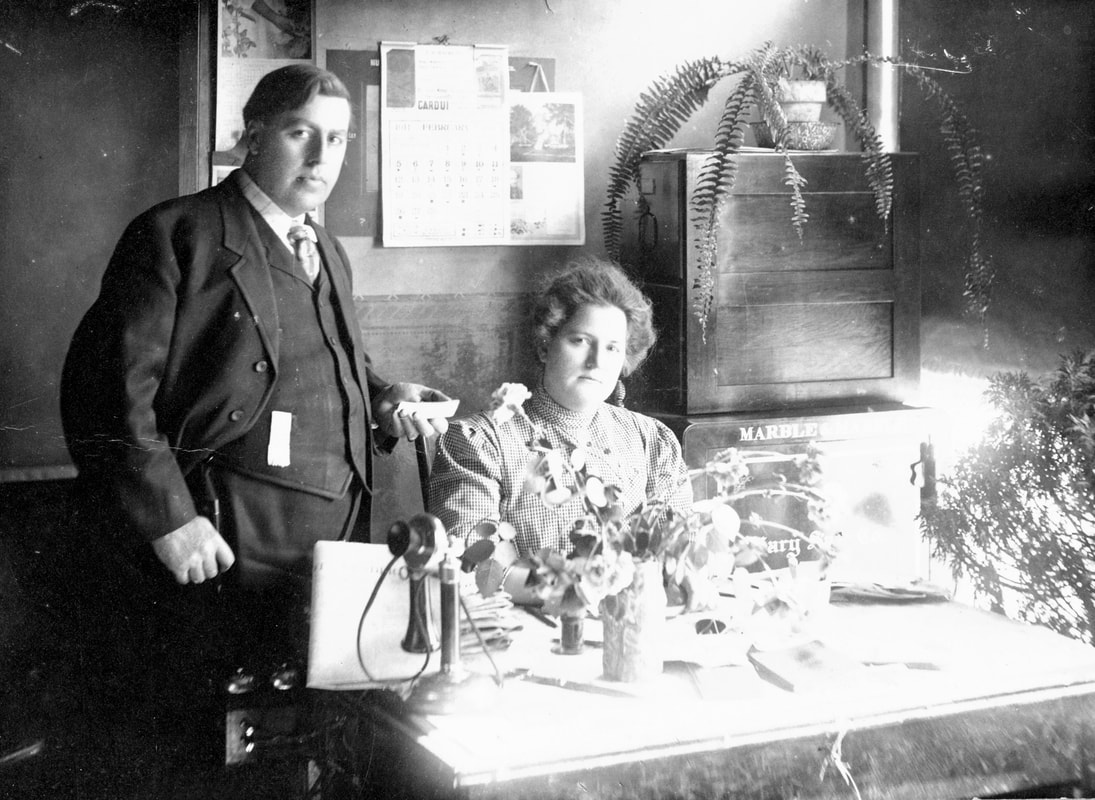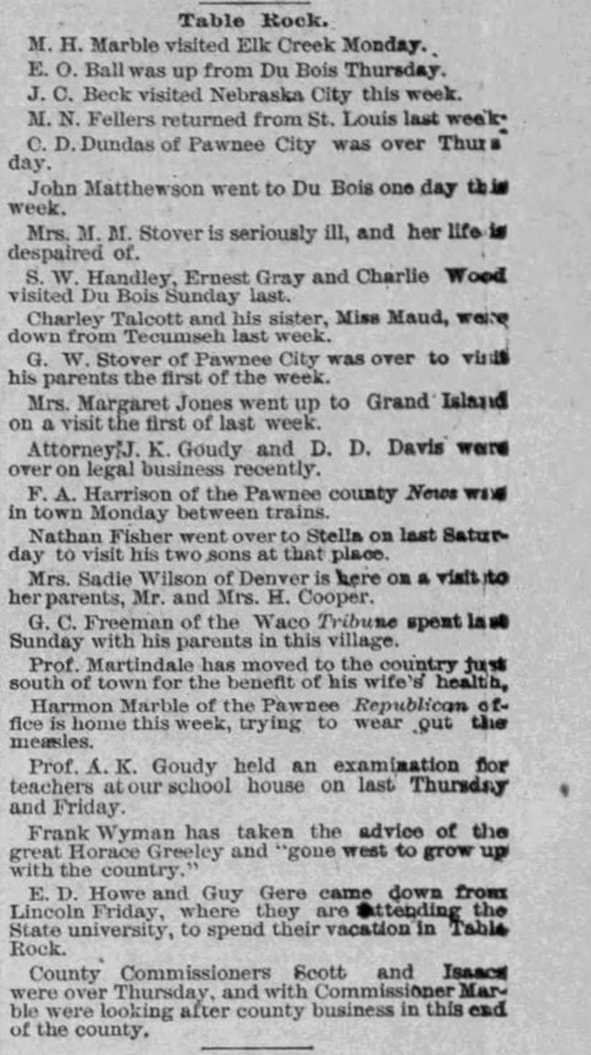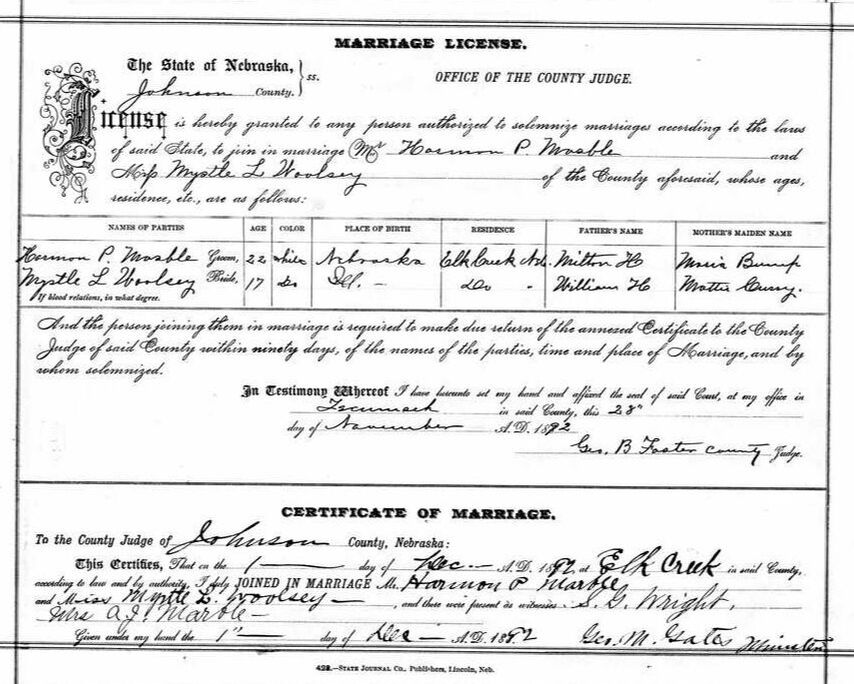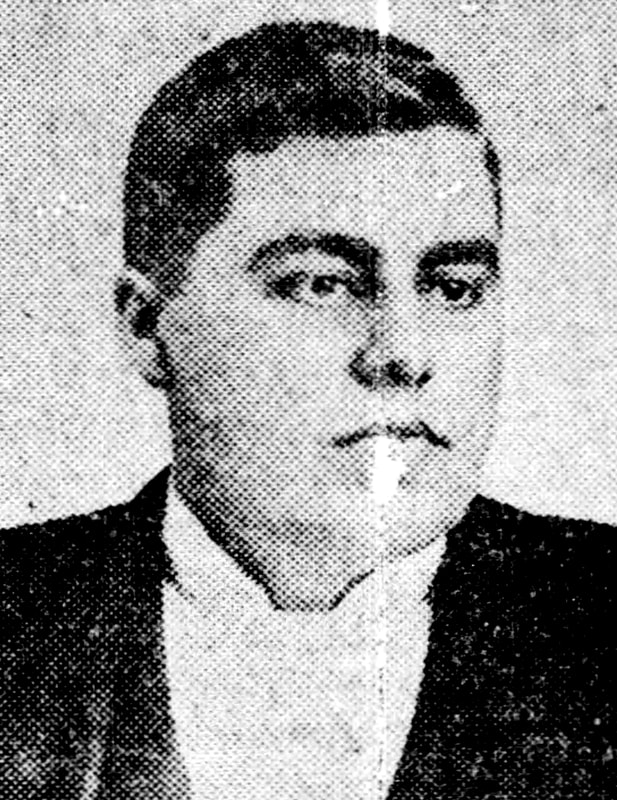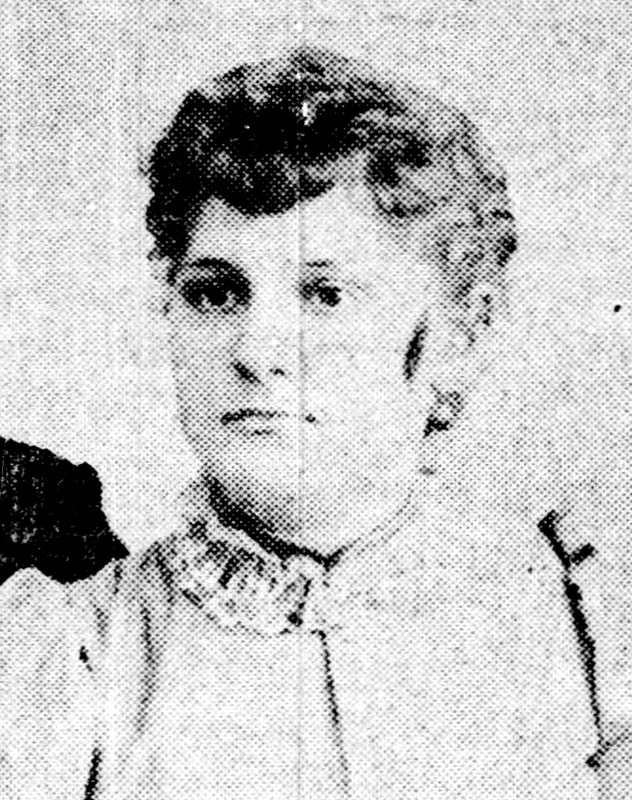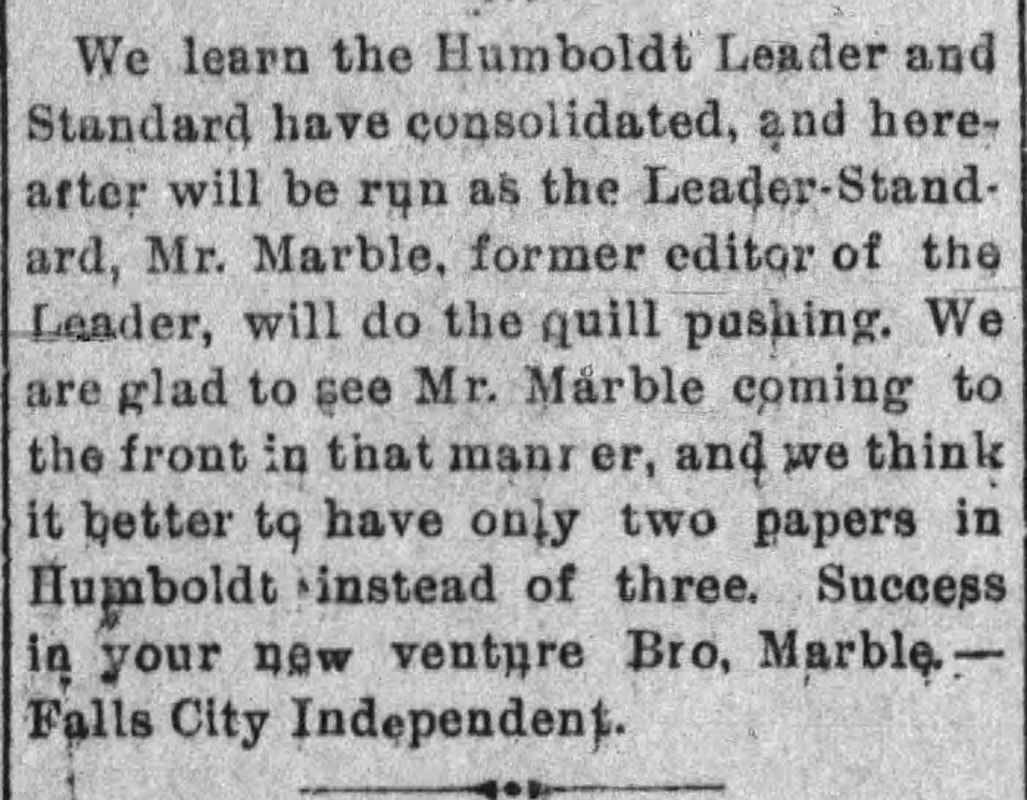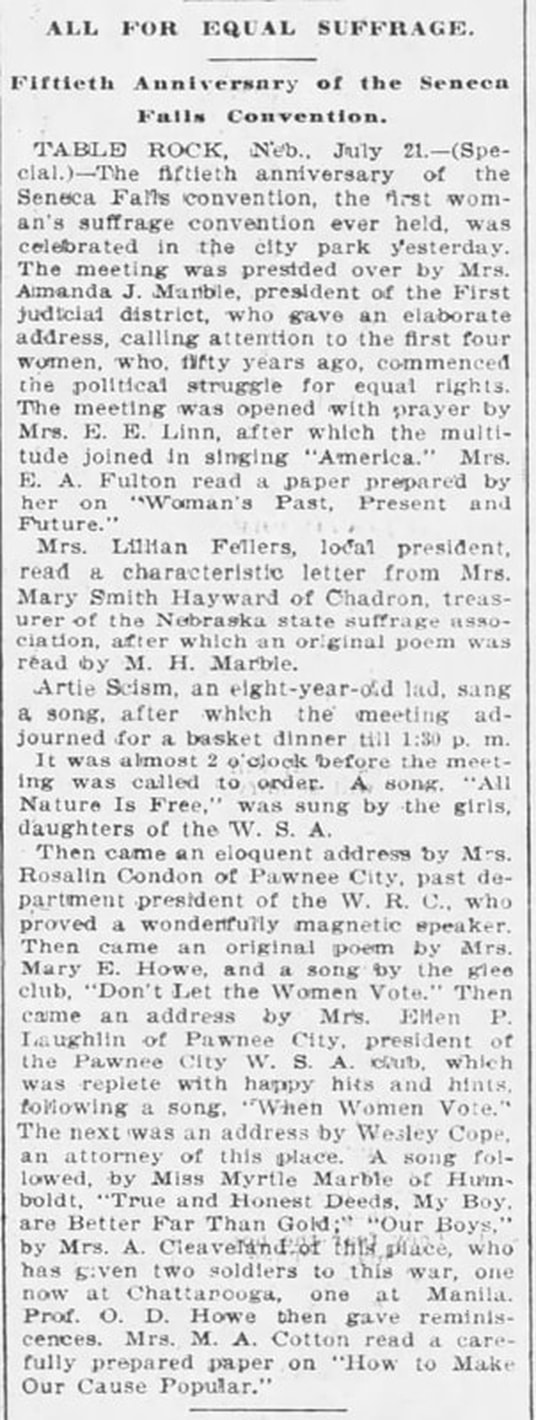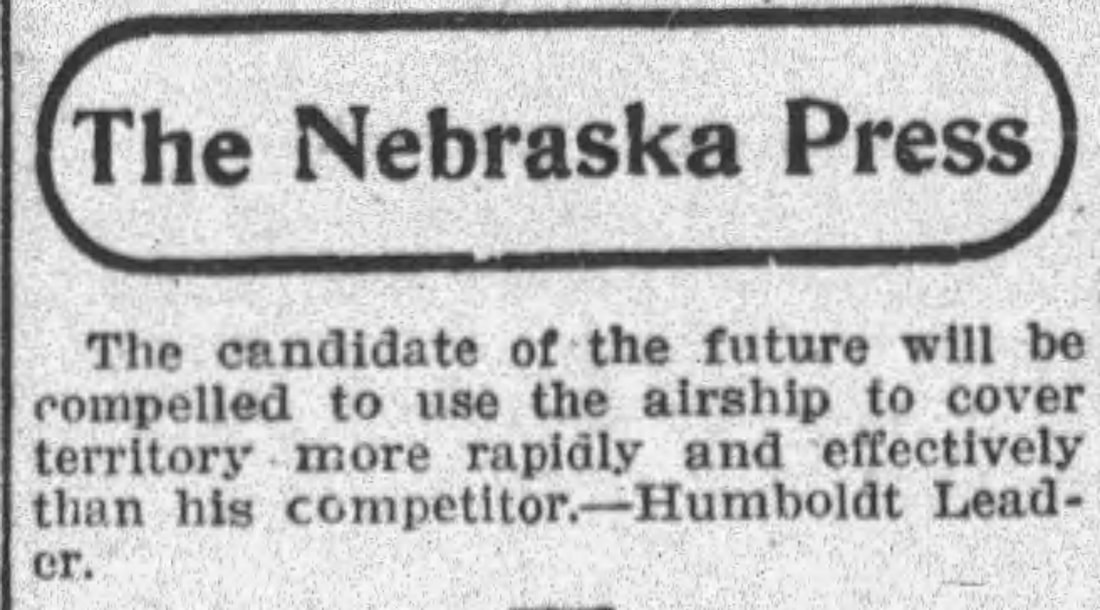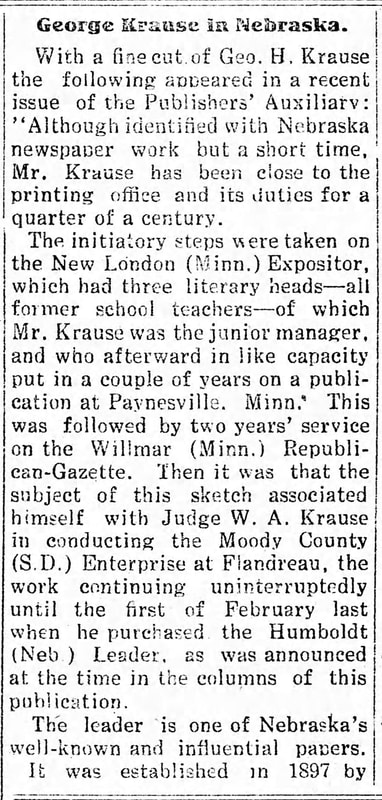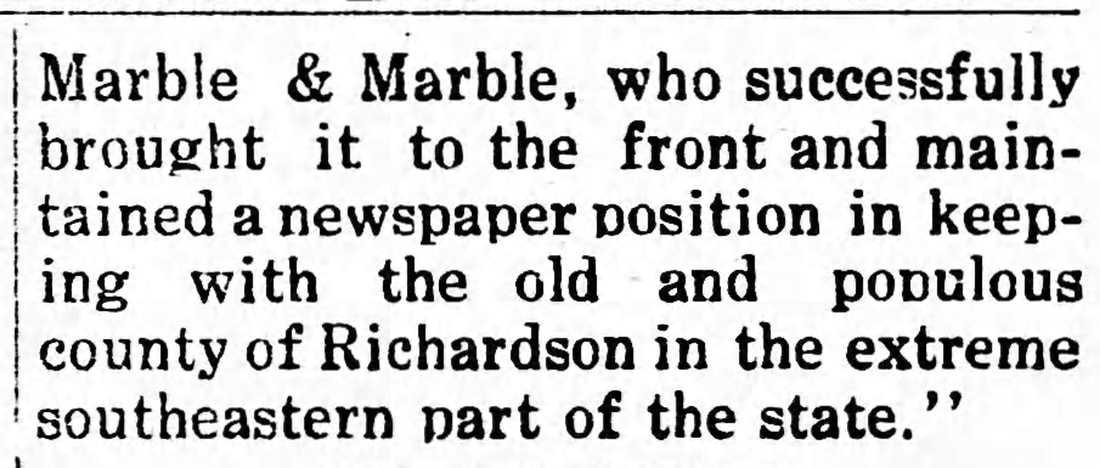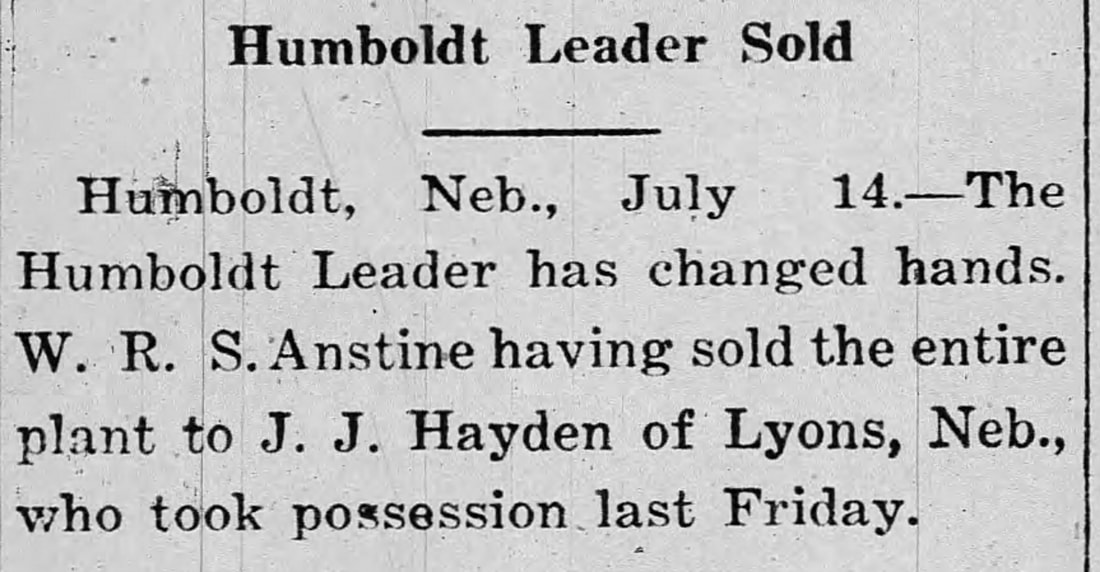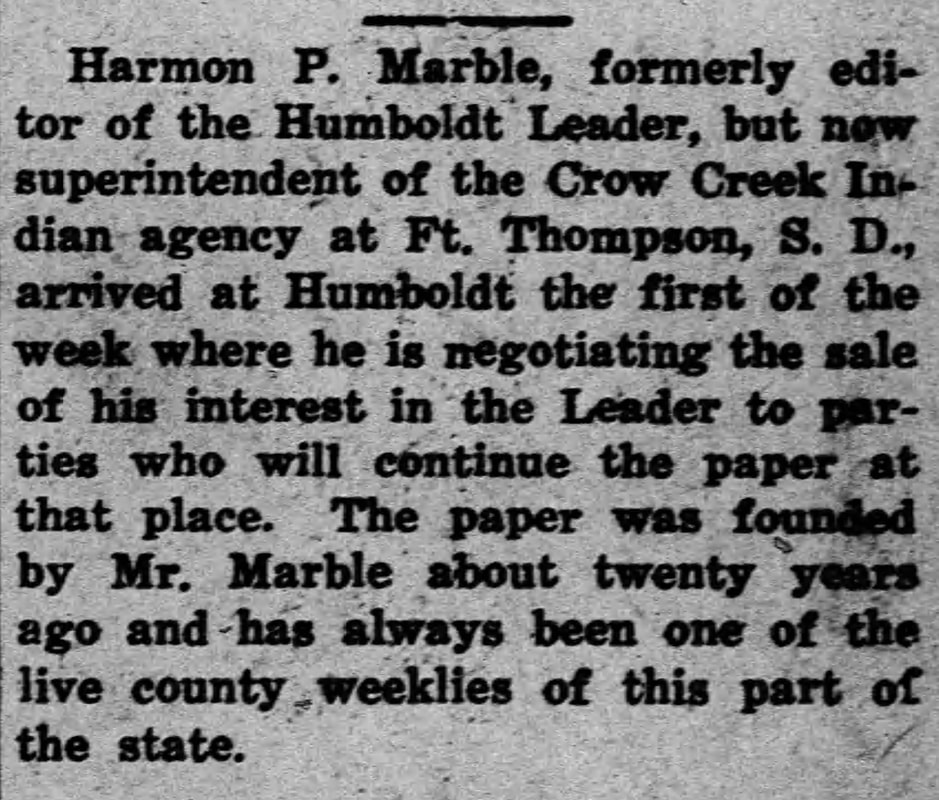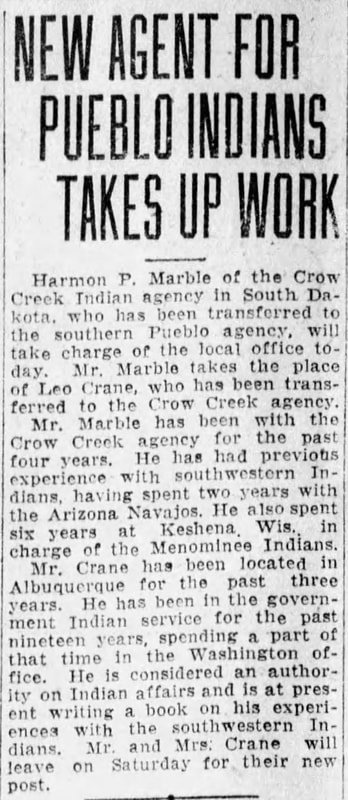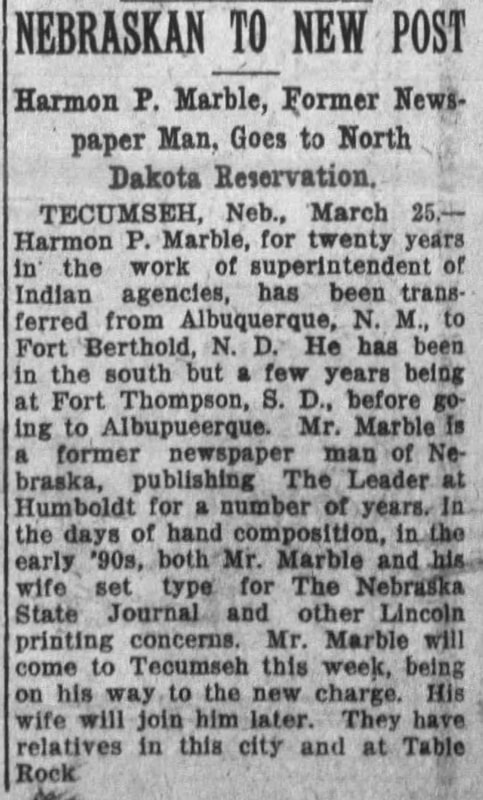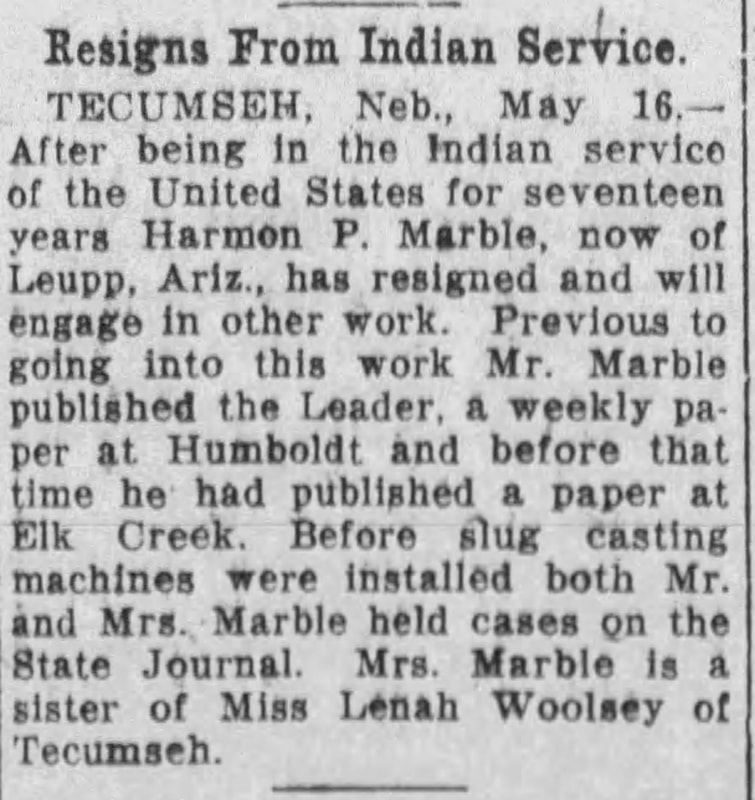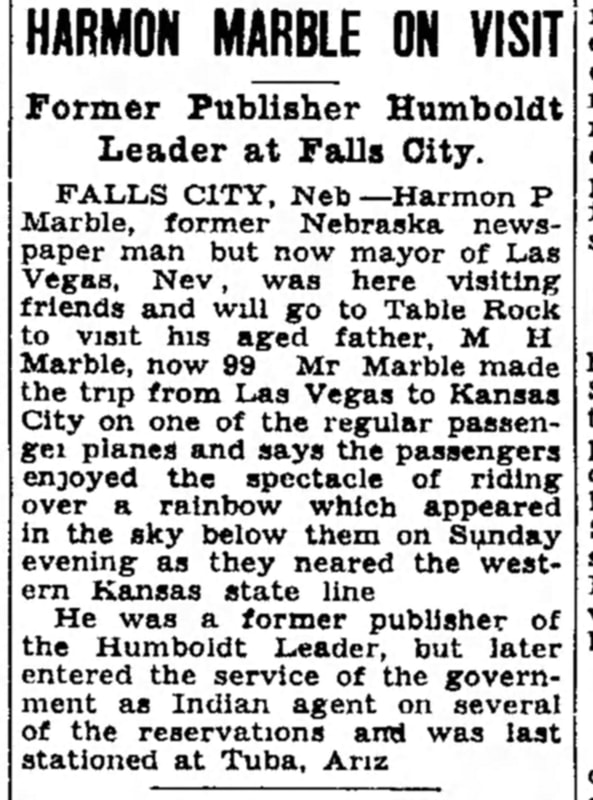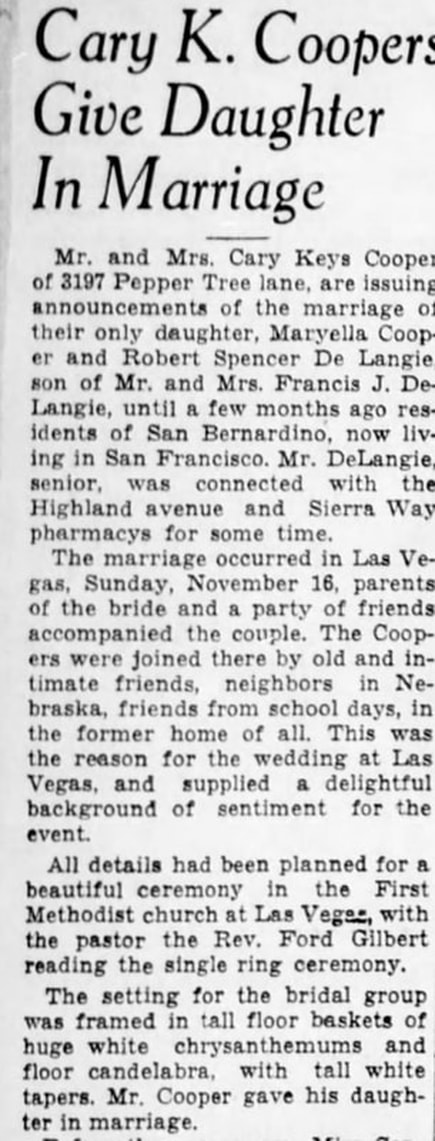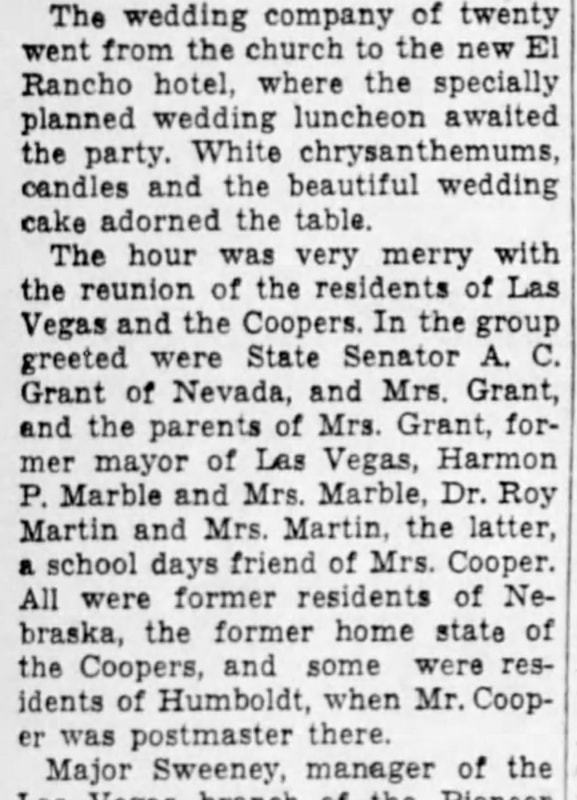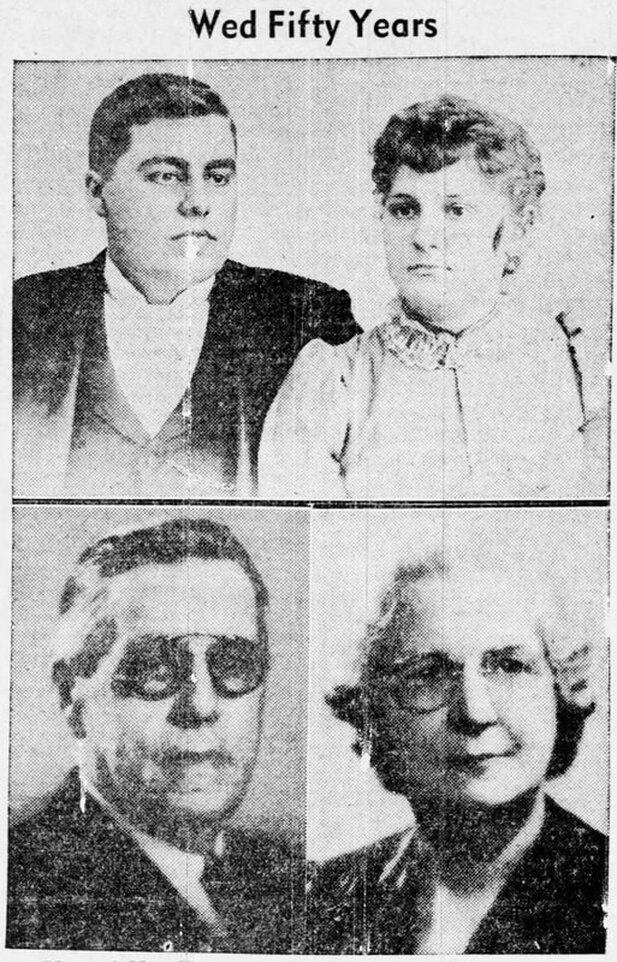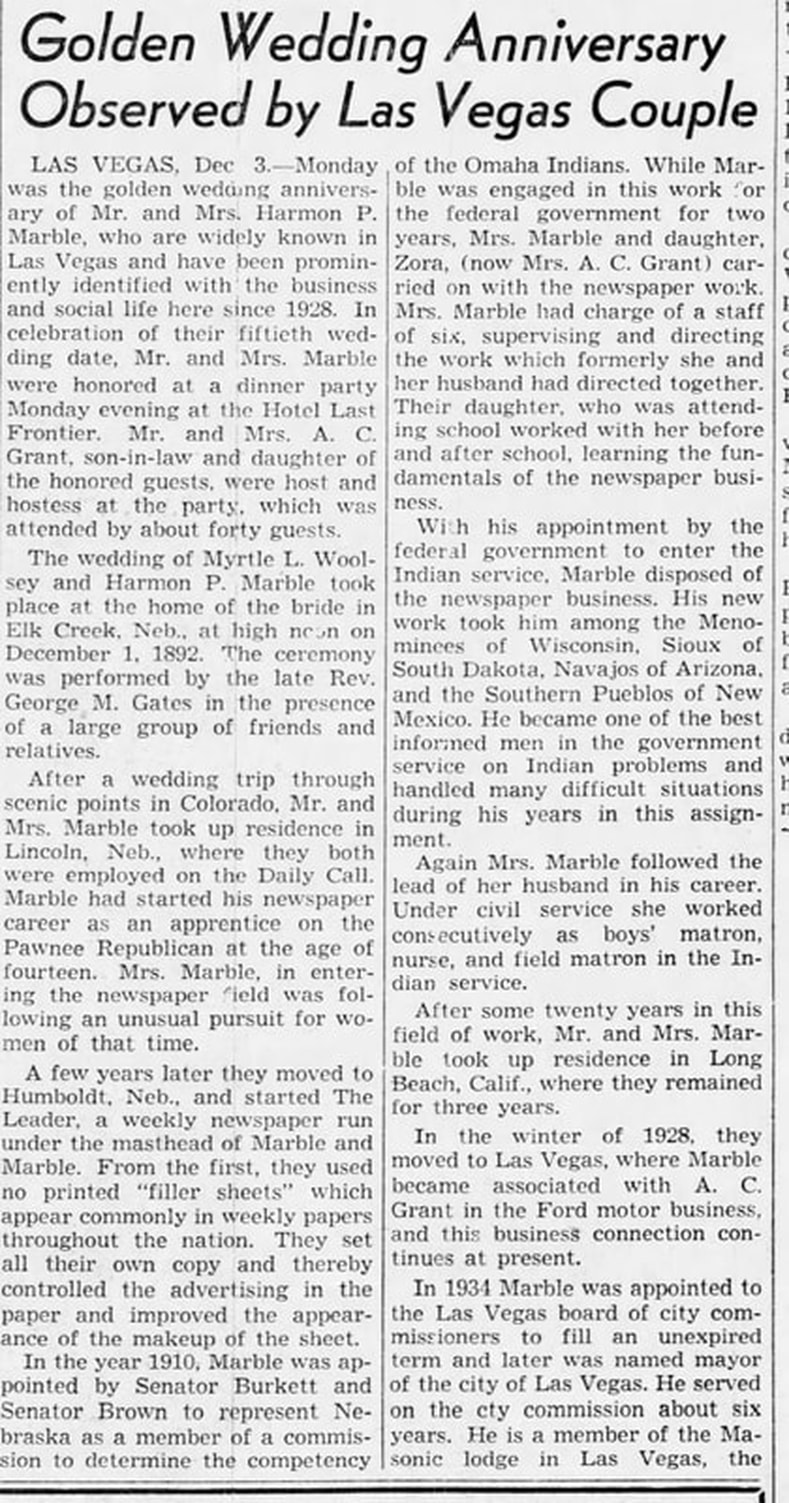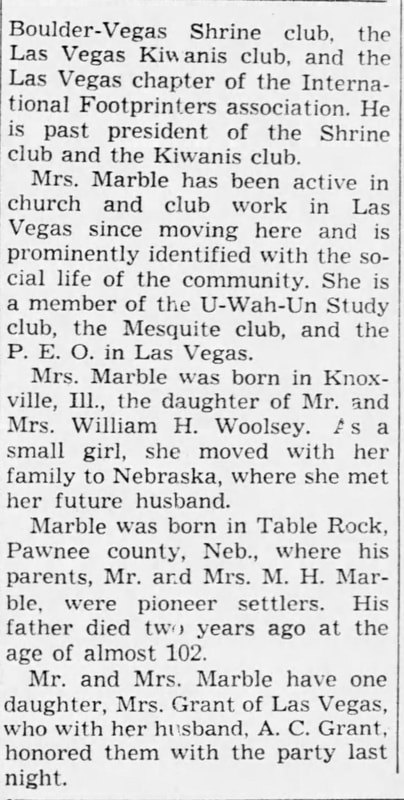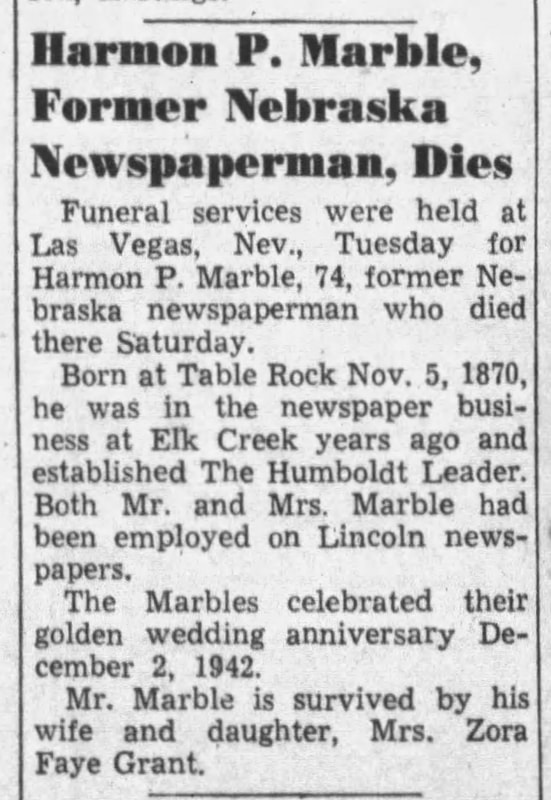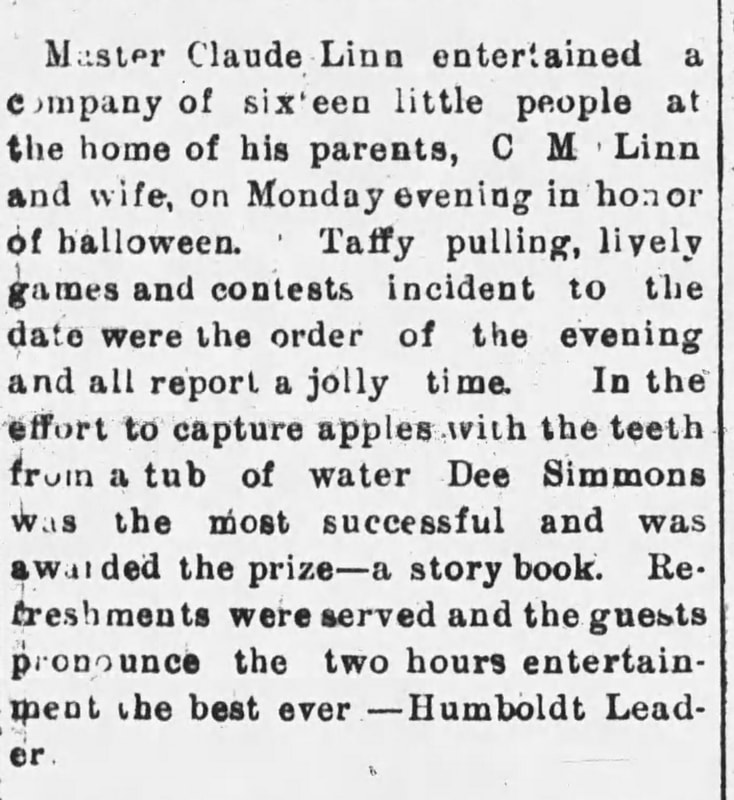worth remembering
Harmon P. & myrtle w. marble
myrtle woolsey marble
newspaper editor & more
This article by Sharla Sitzman was originally written for the Humboldt Standard. She chose Myrtle as the focus for the simple reason that men from that time usually get all the credit, with the woman as an "also." Myrtle may have been "Mrs. H. P. Marble" but she was quite a unique person in her own right, which showed through in the earlier days before her husband's career as Indian agent and later politician took over.
Her husband was the mayor of Las Vegas and even has his own Wikipedia entry. Her son-in-law was a Nevada senator for whom a building at the University of Nevada was named and still stands. She must have been hostess at many a party. But before that, she belonged to a cluster of us – especially Elk Creek, Humboldt, and Table Rock. And let me tell you, she was worth claiming!
Here is a little story about Myrtle Marble, a woman who died 70 years ago.
Myrtle’s father, William Woolsey, fought in the Civil War, with the 7th Illinois Cavalry. Her father’s father and uncle did, too. The year after the war ended, William got married and started a family. Illinois farmers were coming to Nebraska like crazy until the 1880s, and in 1877 the Woolsey family joined the migration. By then, there were 4 kids, Myrtle being the 3rd, age 2. They made a new home near Elk Creek.
A momentous occasion took place when Myrtle was 17. She got married. Her new husband was a Table Rock fellow. His name was Harmon Marble, and he was the son of M. H. and Maria Marble, born in Table Rock soon after their arrival in 1870. His mother had died when he was a baby and his father soon remarried a woman named Amanda Linn, who was the only mother Harmon ever knew.
When Myrtle married Harmon in 1892, he was 22 and an experienced newspaperman by that time. He had learned his trade working at the Pawnee Republican for two years. His dad had for a while been associate editor of the new paper in Table Rock, the Argus. Harmon was only 14 when he embarked on his own newspaper career in 1884. When he was 16, Harmon left the Republican. When he was 18, he founded his own newspaper, the Elk Creek Sentinel. The year was 1888. The sentinel was said to be a “bright, cheery” paper run by a young man of “character, ability, and enterprise.” I don’t think the Sentinel survived more than a couple of years. History Nebraska gives the publication dates as “1888-189?.”
Anyway, after the wedding, Myrtle and her husband Harmon made Lincoln their home. They both got a job at the Daily Call newspaper and later also worked for the Nebraska State Journal. Women were not in the newspaper business back then, but there she was! The couple set type. That’s right, they each sat at a case and set type. Back then, those new-fangled typewriters may have begun to be used more, but linotype machines were not. Myrtle and her husband created newspaper articles letter by letter, using tweezers to place each tiny lead letter on a bar. When a line was done, they would slide it into a galley, and on to the next line. Don’t forget the letters were mirror images, and small.
In 1897, another momentous occasion: they moved to Humboldt. By then they were three, Harmon, Myrtle, and daughter Zora. The little family’s purpose in Humboldt was to establish a third newspaper in town, a weekly they called the Humboldt Leader.
The paper’s motto was, “A live newspaper for live people!” It sounds funny now, but back then, there was value placed in “live” people and on “wide awake” people, the way then of describing people with energy, focus, and purpose.
Only Harmon’s name was on the masthead the first issue of the Humboldt Leader. Within months, Harmon’s name no longer stood alone. “Myrtle W. Marble, Assistant Editor,” was added. I emphasize that she used her first name: Myrtle W. Marble. She was not hidden behind initials! She was a newspaper editor, and she was a woman. Within a few years, there were co-editors: “H. P. & Myrtle W. Marble.”
In their old age, Harmon and Myrtle recalled with pride that they never used the pre- printed ‘filler sheets’ that were common to weeklies back then. “They set all their own copy and thereby controlled the advertising in the paper and improved the appearance” of the paper. I suppose some of the innovative advertisements were helped by that local control. Ads of the day often had hooks, but the ones in the Leader were brilliant. “Do you wear clothes? If so, why not wear the best?” Another: “My hair ran away! Don’t have a fall out with your hair, or it may leave you! Then what?”
Myrtle soon spread her wings even farther than the typesetting cases of the big city and the editor’s desk at the Leader. She became involved in the suffrage movement, i.e., the movement seeking the vote for women. Here she was in the newspaper business, reporting on politics and other weighty affairs, and did not even have the right to vote. It was a complicated time, with the suffragist and temperance movements often intertwined. Often, if you wanted to drink, you didn’t want women to vote, and vice versa.
In 1898, a big celebration was held in the Table Rock square to celebrate the 50th year of the suffrage movement. The main speaker was Amanda Linn Marble, Harmon’s stepmother, a district president of the Nebraska suffragists. It was a long program, with a meeting, a basket dinner, and many many MANY speeches. Toward the end, Myrtle sang. She sang a song called, “True and Honest Deeds, My Boy, Are Better Far Then Gold.” The song had been written by Anna Cleaveland. If you have read the trilogy of Cleaveland articles this past month, you may notice recognize Anna as the wife of railroad conductor K. E. Cleaveland, mother of Howard Cleaveland, “crippled coach of champions,” and the grandmother of Link Lyman, early football Pro Hall of Famer.
Myrtle traveled to a state suffrage convention with her mother-in-law Amanda Marble, and in 1904 she and Amanda traveled as representatives of Nebraska to the National Women’s Suffragist Convention in New Orleans. Myrtle also took a part in getting a suffragist movement cookbook printed and distributed, a fundraiser for the movement.
The Leader continued to be a cheerful, newsy paper. For example, that year of 1904 an article birthday party with “16 little people” described a Halloween themed party. “Taffy pulling, lively games and contests incident to the date were the order of the evening and all report a jolly time.” Dee Simmons did best at picking an apple from a tub of water with his teeth, and his prize was a storybook.
In 1907, Marble and Marble celebrated the 10th anniversary of the paper. A newspaper article noted that the occasion would be marked by postcards with a picture of the editors and a copy of the first issue of the Leader in the background. Oh – and Myrtle went to a national suffragist convention in Chicago to represent Nebraska!
In about 1910, Mable’s husband Harmon left the paper. It was not an abandonment, rather a change of occupation. He was appointed by the State of Nebraska to work with the Omaha Indians. It was a time of new beginnings, and also a sad time, because Amanda Marble died unexpectedly that year; she had been Harmon’s mother and Amanda’s great friend and co-suffragist.
Myrtle and her husband didn’t want to move their household just yet. Their daughter Zora was set to graduate from Humboldt High School in 1911. And so Myrtle and Zora stayed in Humboldt. During that time, Myrtle was “the” editor of the Leader, managing a staff of six, “supervising and directing the work which formerly she and her husband had directed together.” Zora came after before and after school to help as well. For two years, there was thus an unofficial Marble & Marble consisting of Myrtle and Zora Marble.
The paper continued to be packed with good stuff to read. (You can review back issues on microfilm at Bruun Memorial Library in Humboldt.) The Leader was quoted by the Lincoln Star for a prediction that the political candidate of the future “will be compelled to use the airship to cover the territory more rapidly and effectively than his competitor.”
After that, Myrtle’s life followed Harmon’s career. Harmon was appointed to the federal Indian Service, and the newspaper was sold.
Over the next 17 years they served successive posts with the Menominees of Wisconsin, the Sioux of South Dakota, the Navajos of Arizona, and the Southern Pueblos of New Mexico. From those years on, Myrtle as an individual virtually disappeared from history.
In 1921, Zora married a young man named A. C. Grant, Archie. Archie’s family had lived in Wisconsin in the area of the Menominee Indians, where the Marble family also was stationed, and I suppose that’s where they had met. Zora and Archie eventually went to Las Vegas, where Archie established a Ford dealership.
In 1928, Myrtle and Harmon moved to Las Vegas, where Harmon joined Archie in the Ford business. There were two other Las Vegas residents that Myrtle and Harmon knew, a couple who originally hailed from Table Rock, Dr. Roy Martin and his wife Nellie. Dr. Martin was a son of G.R. Martin, who built the Table Rock Opera House.
There were only about 5,000 people in Las Vegas when Myrtle and Harmon arrived. Not much was happening in Las Vegas until 1931, when work on the Hoover Dam began. The population exploded. When the damn was started, the first street in Las Vegas was paved, Fremont Street, and the first casinos were built.
By 1934, Harmon became a city commissioner. The dam was finished in 1935 and electricity came to town in 1937. And in 1938, Harmon became the mayor for two years. And Myrtle was the mayor’s wife. Harmon was a Shriner and belonged to the Kiwanis Club. Myrtle? All l can find is that she was “prominently identified with the social life of the community.”
In 1938, Mayor & Mrs. Marble visited Table Rock for the 99th birthday of Harmon’s father, M. H. The first step of the journey was by passenger airplane from Las Vegas to Kansas City. It was a huge deal back then. They reported enjoying “the spectacle of riding over a rainbow which appeared in the sky below them as they neared the western Kansas state line.”
In 1942, there was a huge 50th anniversary celebration for Myrtle and Harmon. Harmon was in poor health by that time, and passed away in 1945 at the age of 74.
Myrtle died in 1951 at the age of 76. Her obituary said briefly that she “had been one of the early campaigners in Nebraska for women’s suffrage, and during her lifetime had been a newspaper writer, a typesetter, and counselor to Indian women on the reservations where her husband served.” Her career as editor of the Humboldt Standard was forgotten nor did anything else of her personality survive.
It’s too bad that Myrtle’s passing did not trigger more hoopla, or that more about her is not known. There are no descendants to tell us. Zora and Archie had only one child, who died young. I think that Myrtle Marble was probably a real humdinger of a woman! I wish I had known her!
Here is a little story about Myrtle Marble, a woman who died 70 years ago.
Myrtle’s father, William Woolsey, fought in the Civil War, with the 7th Illinois Cavalry. Her father’s father and uncle did, too. The year after the war ended, William got married and started a family. Illinois farmers were coming to Nebraska like crazy until the 1880s, and in 1877 the Woolsey family joined the migration. By then, there were 4 kids, Myrtle being the 3rd, age 2. They made a new home near Elk Creek.
A momentous occasion took place when Myrtle was 17. She got married. Her new husband was a Table Rock fellow. His name was Harmon Marble, and he was the son of M. H. and Maria Marble, born in Table Rock soon after their arrival in 1870. His mother had died when he was a baby and his father soon remarried a woman named Amanda Linn, who was the only mother Harmon ever knew.
When Myrtle married Harmon in 1892, he was 22 and an experienced newspaperman by that time. He had learned his trade working at the Pawnee Republican for two years. His dad had for a while been associate editor of the new paper in Table Rock, the Argus. Harmon was only 14 when he embarked on his own newspaper career in 1884. When he was 16, Harmon left the Republican. When he was 18, he founded his own newspaper, the Elk Creek Sentinel. The year was 1888. The sentinel was said to be a “bright, cheery” paper run by a young man of “character, ability, and enterprise.” I don’t think the Sentinel survived more than a couple of years. History Nebraska gives the publication dates as “1888-189?.”
Anyway, after the wedding, Myrtle and her husband Harmon made Lincoln their home. They both got a job at the Daily Call newspaper and later also worked for the Nebraska State Journal. Women were not in the newspaper business back then, but there she was! The couple set type. That’s right, they each sat at a case and set type. Back then, those new-fangled typewriters may have begun to be used more, but linotype machines were not. Myrtle and her husband created newspaper articles letter by letter, using tweezers to place each tiny lead letter on a bar. When a line was done, they would slide it into a galley, and on to the next line. Don’t forget the letters were mirror images, and small.
In 1897, another momentous occasion: they moved to Humboldt. By then they were three, Harmon, Myrtle, and daughter Zora. The little family’s purpose in Humboldt was to establish a third newspaper in town, a weekly they called the Humboldt Leader.
The paper’s motto was, “A live newspaper for live people!” It sounds funny now, but back then, there was value placed in “live” people and on “wide awake” people, the way then of describing people with energy, focus, and purpose.
Only Harmon’s name was on the masthead the first issue of the Humboldt Leader. Within months, Harmon’s name no longer stood alone. “Myrtle W. Marble, Assistant Editor,” was added. I emphasize that she used her first name: Myrtle W. Marble. She was not hidden behind initials! She was a newspaper editor, and she was a woman. Within a few years, there were co-editors: “H. P. & Myrtle W. Marble.”
In their old age, Harmon and Myrtle recalled with pride that they never used the pre- printed ‘filler sheets’ that were common to weeklies back then. “They set all their own copy and thereby controlled the advertising in the paper and improved the appearance” of the paper. I suppose some of the innovative advertisements were helped by that local control. Ads of the day often had hooks, but the ones in the Leader were brilliant. “Do you wear clothes? If so, why not wear the best?” Another: “My hair ran away! Don’t have a fall out with your hair, or it may leave you! Then what?”
Myrtle soon spread her wings even farther than the typesetting cases of the big city and the editor’s desk at the Leader. She became involved in the suffrage movement, i.e., the movement seeking the vote for women. Here she was in the newspaper business, reporting on politics and other weighty affairs, and did not even have the right to vote. It was a complicated time, with the suffragist and temperance movements often intertwined. Often, if you wanted to drink, you didn’t want women to vote, and vice versa.
In 1898, a big celebration was held in the Table Rock square to celebrate the 50th year of the suffrage movement. The main speaker was Amanda Linn Marble, Harmon’s stepmother, a district president of the Nebraska suffragists. It was a long program, with a meeting, a basket dinner, and many many MANY speeches. Toward the end, Myrtle sang. She sang a song called, “True and Honest Deeds, My Boy, Are Better Far Then Gold.” The song had been written by Anna Cleaveland. If you have read the trilogy of Cleaveland articles this past month, you may notice recognize Anna as the wife of railroad conductor K. E. Cleaveland, mother of Howard Cleaveland, “crippled coach of champions,” and the grandmother of Link Lyman, early football Pro Hall of Famer.
Myrtle traveled to a state suffrage convention with her mother-in-law Amanda Marble, and in 1904 she and Amanda traveled as representatives of Nebraska to the National Women’s Suffragist Convention in New Orleans. Myrtle also took a part in getting a suffragist movement cookbook printed and distributed, a fundraiser for the movement.
The Leader continued to be a cheerful, newsy paper. For example, that year of 1904 an article birthday party with “16 little people” described a Halloween themed party. “Taffy pulling, lively games and contests incident to the date were the order of the evening and all report a jolly time.” Dee Simmons did best at picking an apple from a tub of water with his teeth, and his prize was a storybook.
In 1907, Marble and Marble celebrated the 10th anniversary of the paper. A newspaper article noted that the occasion would be marked by postcards with a picture of the editors and a copy of the first issue of the Leader in the background. Oh – and Myrtle went to a national suffragist convention in Chicago to represent Nebraska!
In about 1910, Mable’s husband Harmon left the paper. It was not an abandonment, rather a change of occupation. He was appointed by the State of Nebraska to work with the Omaha Indians. It was a time of new beginnings, and also a sad time, because Amanda Marble died unexpectedly that year; she had been Harmon’s mother and Amanda’s great friend and co-suffragist.
Myrtle and her husband didn’t want to move their household just yet. Their daughter Zora was set to graduate from Humboldt High School in 1911. And so Myrtle and Zora stayed in Humboldt. During that time, Myrtle was “the” editor of the Leader, managing a staff of six, “supervising and directing the work which formerly she and her husband had directed together.” Zora came after before and after school to help as well. For two years, there was thus an unofficial Marble & Marble consisting of Myrtle and Zora Marble.
The paper continued to be packed with good stuff to read. (You can review back issues on microfilm at Bruun Memorial Library in Humboldt.) The Leader was quoted by the Lincoln Star for a prediction that the political candidate of the future “will be compelled to use the airship to cover the territory more rapidly and effectively than his competitor.”
After that, Myrtle’s life followed Harmon’s career. Harmon was appointed to the federal Indian Service, and the newspaper was sold.
Over the next 17 years they served successive posts with the Menominees of Wisconsin, the Sioux of South Dakota, the Navajos of Arizona, and the Southern Pueblos of New Mexico. From those years on, Myrtle as an individual virtually disappeared from history.
In 1921, Zora married a young man named A. C. Grant, Archie. Archie’s family had lived in Wisconsin in the area of the Menominee Indians, where the Marble family also was stationed, and I suppose that’s where they had met. Zora and Archie eventually went to Las Vegas, where Archie established a Ford dealership.
In 1928, Myrtle and Harmon moved to Las Vegas, where Harmon joined Archie in the Ford business. There were two other Las Vegas residents that Myrtle and Harmon knew, a couple who originally hailed from Table Rock, Dr. Roy Martin and his wife Nellie. Dr. Martin was a son of G.R. Martin, who built the Table Rock Opera House.
There were only about 5,000 people in Las Vegas when Myrtle and Harmon arrived. Not much was happening in Las Vegas until 1931, when work on the Hoover Dam began. The population exploded. When the damn was started, the first street in Las Vegas was paved, Fremont Street, and the first casinos were built.
By 1934, Harmon became a city commissioner. The dam was finished in 1935 and electricity came to town in 1937. And in 1938, Harmon became the mayor for two years. And Myrtle was the mayor’s wife. Harmon was a Shriner and belonged to the Kiwanis Club. Myrtle? All l can find is that she was “prominently identified with the social life of the community.”
In 1938, Mayor & Mrs. Marble visited Table Rock for the 99th birthday of Harmon’s father, M. H. The first step of the journey was by passenger airplane from Las Vegas to Kansas City. It was a huge deal back then. They reported enjoying “the spectacle of riding over a rainbow which appeared in the sky below them as they neared the western Kansas state line.”
In 1942, there was a huge 50th anniversary celebration for Myrtle and Harmon. Harmon was in poor health by that time, and passed away in 1945 at the age of 74.
Myrtle died in 1951 at the age of 76. Her obituary said briefly that she “had been one of the early campaigners in Nebraska for women’s suffrage, and during her lifetime had been a newspaper writer, a typesetter, and counselor to Indian women on the reservations where her husband served.” Her career as editor of the Humboldt Standard was forgotten nor did anything else of her personality survive.
It’s too bad that Myrtle’s passing did not trigger more hoopla, or that more about her is not known. There are no descendants to tell us. Zora and Archie had only one child, who died young. I think that Myrtle Marble was probably a real humdinger of a woman! I wish I had known her!
notes
According to Nina Martyris, in her article on NPR Iowa Public Radio published in 2015, the first Women's Suffrage Cookbook was published in 1886. History of Women's Suffrage: 1900-1920 edited by Elizabeth Cady Stanton, et al., states that Marble took part in the cookbook initiative in 1904 by helping to publish and mail the books. Nina Martyris also claims that these cookbooks were used as a fundraiser for the suffrage movement. This was arguably the most influential project Marble took part in because it raised awareness of the issues with discrimination against women and raised money for the suffrage cause.
The Omaha Daily Bee, published on March 17, 1903, states that Marble took part in other suffragist activities. For instance, the newspaper details how she attended the National Women's Suffrage Convention in New Orleans to represent Nebraska. The Omaha Daily Bee, published on February 3, 1907, also states that Marble was a member of the Nebraska Women's Suffrage Association, and in 1907, she attended the Chicago meeting to represent Nebraska.
According to the 1920 and 1940 United States Federal Census given by ancestry.com, Marble and her family moved to South Dakota and Las Vegas. The California Death Index from 1940-1997 from ancestry.com also provides her death certificate, revealing that she died in Los Angeles in 1951. Marble and her family were primarily following Harmon's career; however, Myrtle was also independent in her works as a suffragist.
The Omaha Daily Bee, published on March 17, 1903, states that Marble took part in other suffragist activities. For instance, the newspaper details how she attended the National Women's Suffrage Convention in New Orleans to represent Nebraska. The Omaha Daily Bee, published on February 3, 1907, also states that Marble was a member of the Nebraska Women's Suffrage Association, and in 1907, she attended the Chicago meeting to represent Nebraska.
According to the 1920 and 1940 United States Federal Census given by ancestry.com, Marble and her family moved to South Dakota and Las Vegas. The California Death Index from 1940-1997 from ancestry.com also provides her death certificate, revealing that she died in Los Angeles in 1951. Marble and her family were primarily following Harmon's career; however, Myrtle was also independent in her works as a suffragist.
SOURCE MATERIALS
general biographical information
Harmon Marble has his own wikipedia entry! https://en.wikipedia.org/wiki/Harmon_Percy_Marble.
About the wikipedia entry for Harmon Marble: A source on the wikipedia entry has a YouTube video showing a slide show of his works. The Wikipedia notes his unartistic but honest portrayal and the description with this video says: "Harmon Percy Marble extensively documented Native America. The Indian Agent was born in 1870 and entered Government Indian Service in 1911. Until he retired in 1926, Marble was assigned to many reservations in the Plains and Southwest areas. While his images lack some of the quality of others, his possibly is the most honest portrayal of actual Native American life at the time."
Another source that the Wikipedia article listed is a nice collection accompanied by an anthropology professor's commentary: https://web.archive.org/web/20130121191927/http://www.nativeamericanlinks.com/harmonmarble.htm
Harmon Marble founded the Humboldt Leader in 1897, Myrtle joined as editor at some point and became sold working editor toward then end, and they sold it in 1911. Unsourced history.
Photograph of Harmon & Myrtle's only child, Zora Marble Grant: index of University of Las Vegas archive collection says it includes pictures of Zora: https://www.library.unlv.edu/speccol/databases/index.php?coll=photocoll&recid=100
FANTASTIC WOODS FAMILY TREE, includes Marbles: https://www.ancestry.com/family-tree/person/tree/20215823/person/918550492/facts
About the wikipedia entry for Harmon Marble: A source on the wikipedia entry has a YouTube video showing a slide show of his works. The Wikipedia notes his unartistic but honest portrayal and the description with this video says: "Harmon Percy Marble extensively documented Native America. The Indian Agent was born in 1870 and entered Government Indian Service in 1911. Until he retired in 1926, Marble was assigned to many reservations in the Plains and Southwest areas. While his images lack some of the quality of others, his possibly is the most honest portrayal of actual Native American life at the time."
Another source that the Wikipedia article listed is a nice collection accompanied by an anthropology professor's commentary: https://web.archive.org/web/20130121191927/http://www.nativeamericanlinks.com/harmonmarble.htm
Harmon Marble founded the Humboldt Leader in 1897, Myrtle joined as editor at some point and became sold working editor toward then end, and they sold it in 1911. Unsourced history.
Photograph of Harmon & Myrtle's only child, Zora Marble Grant: index of University of Las Vegas archive collection says it includes pictures of Zora: https://www.library.unlv.edu/speccol/databases/index.php?coll=photocoll&recid=100
FANTASTIC WOODS FAMILY TREE, includes Marbles: https://www.ancestry.com/family-tree/person/tree/20215823/person/918550492/facts
Biographical sketch, modern, Iowa "Biographical Sketch of Myrtle W. Marble, written by Haley Spengler. Included in Biographical Database of NAWSA Suffragists, 1890-1920": https://documents.alexanderstreet.com/d/1009656392
FindaGrave.com memorial for Harmon Marble: Findagrave memorial: https://www.findagrave.com/memorial/165330051/harmon-percival-marble
FindaGrave.com memorial for Harmon Marble: Findagrave memorial: https://www.findagrave.com/memorial/165330051/harmon-percival-marble
harmon's photographs of native americans
Auction, looks like 2013, of images, collection $9,200. https://www.morphyauctions.com/jamesdjulia/item/lot-2179-outstanding-lot-of-over-300-native-american-photographs-by-harmon-p-marble-27417/
Pinterest site with his photos: https://www.pinterest.com/sonyaneumann/harmon-percy-marble-photographs-native-americans-n/
Images for search for him; he photographed native americans, Ebay photos listed for hundreds of dollars each. https://www.google.com/search?q=harmon+p.+marble&sxsrf=ALeKk01HjFKjVxDpt_YUmAE3qv5QtZkjTQ:1611597614524&tbm=isch&source=iu&ictx=1&fir=hi1PiHh0uiAK8M%252CDFBB-F6ydZpngM%252C_&vet=1&usg=AI4_-kSIYutw4gb6OCG5XpWUDDNpe9TKOQ&sa=X&ved=2ahUKEwjvnNb61LfuAhWpxVkKHf55D5IQ9QF6BAgGEAE#imgrc=hi1PiHh0uiAK8M
Pinterest site with his photos: https://www.pinterest.com/sonyaneumann/harmon-percy-marble-photographs-native-americans-n/
Images for search for him; he photographed native americans, Ebay photos listed for hundreds of dollars each. https://www.google.com/search?q=harmon+p.+marble&sxsrf=ALeKk01HjFKjVxDpt_YUmAE3qv5QtZkjTQ:1611597614524&tbm=isch&source=iu&ictx=1&fir=hi1PiHh0uiAK8M%252CDFBB-F6ydZpngM%252C_&vet=1&usg=AI4_-kSIYutw4gb6OCG5XpWUDDNpe9TKOQ&sa=X&ved=2ahUKEwjvnNb61LfuAhWpxVkKHf55D5IQ9QF6BAgGEAE#imgrc=hi1PiHh0uiAK8M
information by date
April 9, 1872 - Harmon's mother, Maria Bump Marble, dies not long after the family arrives in Table Rock (1870). She was only 28. Her oldest, Edith, was almost 7 years old; Alice was 5, and Harmon was about 18 months.
October 31, 1872 -- Harmon acquires a loving step mother as his father marries Amanda Linn. (Amanda would pass away in 1910, at the age of 64.)
March 27, 1887 Nebraska State Journal. Harmon, still living in Table Rock, went to Elk Creek for a visit. (He was about 15.)
July 12, 1891 Nebrask State Journal. Harmon, now of Elk Creek, visits Pawnee City. (Article appears in the Pawnee City socials column.)
December 1, 1892, Harmon Percy Marble, by then of Elk Creek, married Myrtle P,. Woolsey at her parents' home in Elk Creek:.
1892 wedding portraits of Harmon & Myrtle, from a 1942 article about their 50th wedding anniversary
August 6, 1897 Dawson (Nebraska) News Boy:
July 22, 1898 Nebraska State Journal-- First mention found of suffrage as a cause of Myrtle Marble. A 50th anniversary of suffrage celebration is held in Table Rock, and attended by Myrtle, now of Humboldt.
March 17, 1903 Omaha Daily Bee (Myrtle represented Nebraska at the National Women's Suffrage Convention in New Orlean
1904 - Myrtle took part in a cook book initiative by women's suffragists, helping to publish and mail the books. These books were used as a fundraiser for the suffragist movement, and also raised awareness of the issues of discrionation against women. (Nina Maretyrist, 2015 article for NPR Iowa Public Radio, according to biographical sketch by Haley Spengler in "Biographical Database of NAWSA Suffragists, 1890-1920."
May 23, 1907 Elk Creek Herald
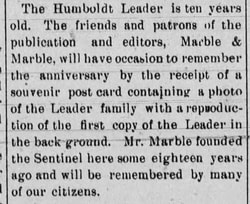
February 3, 1907 Omaha Daily Bee (Mytle belonged to the Nebraska Women's Suffrage Association, and she was a representative from Nebraska at a Chicago meeting of women's suffragists.
April 9, 1910 - Harmon's step mother, Amanda Linn Marble, passes away at age 64. She was the only mother he had known. His mother Maria had died when he was a baby, and Amanda married Harmon's father about six months later.
October 8, 1910 Lincoln Star -- the Leader quoted about prediction that politicians will someday need "airships"
1911 - Harmon's father, M. H. Marble, marries a third time, Amy Linn Marble. (Amy would pass away in 1983 at the age of 98. She was only 27 when she married M. H. Marble, he was 72. Amy Marble was born in 1884, when Harmon was 14. Amy was the daughter of Amanda's half-brother Samuel Linn. Samuel's father Richard Linn was Amanda's father and Amy's grandfather.)
March 15, 1911 Willmar (Minnesota) Tribune: the Leader sold to George Krause, formerly of Minnesota
Meanwhile, back in Humboldt: July 15, 1915 Falls City Journal: Krause has apparently sold the Leader since he boutght it in 1911 and now W. R. S. Anstine has sold it to J. J. Hayden.
Meanwhile, back in Humboldt -- even though Harmon & Myrtle sold the Leader, they apparently retained some sort of interest in it. January 9, 1920 Falls City Journal
June 1, 1922 Albuquerque Journal. H. P. begins stint as agent for Pueblo Indians
June 8, 1922 Albuquerque Journal
June 1, 1924, Lincoln Journal Star. The Marbles headed for North Dakota reservation post. His and her history in the newspaper industry are cited:
May 17, 1926 Nebraska State Journal: H. P. resigns from the Indian Service. His and her history of setting type for the Nebraska State Journal cited.
March 16, 1838 -- Harmon's father, M. H. Marble of Table Rock, turns 99, and there is a big party to celebrate.
July 20, 1938 Lincoln Journal Star
March 16, 1939 -- Harmon's father, M. H. Marble of Table Rock, turns 100.
December 20, 1940 - Harmon's father, M. H. Marble, passes away at the age of 101.
1941: An extended article about the wedding of Zora's daughter in the November 19, 1941 San Bernardino County Sun cites the Marbles (two excerpts)
December 3, 1942 Reno Gazette reports on the 50th wedding anniversary
The 50th wedding anniversary article was originally located in Ancestry. https://www.ancestry.com/discoveryui-content/view/110212319:62116tid=&pid=&queryId=55671205b8b83637b5c1301b6a91c508&_phsrc=pyl770&_phstart=successSource
February 9, 1945 Lincoln Star
representative articles from the humboldt leader
November 11, 1904
1940 - The federal census records that Myrtle lived at 310 South 7th Street, Las Vegas, Nevada with her husband Harmon, and daughter Zora and Zora's husband Archie Grant.https://www.ancestry.com/1940-census/usa/Nevada/Myrtle-Marble_9txh
1951 -- Myrtle died in Los Angeles
1940 - The federal census records that Myrtle lived at 310 South 7th Street, Las Vegas, Nevada with her husband Harmon, and daughter Zora and Zora's husband Archie Grant.https://www.ancestry.com/1940-census/usa/Nevada/Myrtle-Marble_9txh
1951 -- Myrtle died in Los Angeles
Biographical Sketch of Myrtle W. Marble, written by Haley Spengler. Included in Biographical Database of NAWSA Suffragists, 1890-1920. Online at https://documents.alexanderstreet.com/d/1009656392. The text of this online article in full:
Biography of Myrtle W. Marble, 1875-1951
Haley Spengler
Iowa State University
Faculty Sponsor: Sarah Chase Crosby
Subject Librarian: Susan A. Vega Garcia
Printer and Publisher of Woman's Suffrage Cookbook, Member of Nebraska Woman's Suffrage Association
Many women were involved in the suffrage movement, including the lesser-known Myrtle W. Marble. Along with her early life and marriage, Marble took part in many activities and organizations, such as the Women's Suffrage Cook Book and the Nebraska Woman Suffrage Association.
According to the 1880 United States Federal Census given by ancestry.com, Myrtle W. Marble was born as Myrtle W. Wosley. She was born in Illinois sometime around 1875 to William and Martha Wosley. Ancestry.com also reveals, through the Nebraska State Census Collection, 1860-1885, that she had three older brothers and two younger sisters. Based on this information, her family moved from Illinois to Nebraska sometime between 1875 and 1885.
The 1910 United States Federal Census given by ancestry.com claims that Myrtle was married to a man named Harmon Percy Marble. F. Andrew Taylor, from the Las Vegas Review Journal, published in 2014, reveals that Harmon and Myrtle lived in Humboldt, Nebraska together and had a daughter named Zora. Taylor also claims that Harmon was a popular photographer of Native Americans and very involved in Indian affrairs, and that, in 1897, the couple "founded a newspaper company called The Humboldt Leader."
According to Nina Martyris, in her article on NPR Iowa Public Radio published in 2015, the first Women's Suffrage Cookbook was published in 1886. History of Women's Suffrage: 1900-1920 edited by Elizabeth Cady Stanton, et al., states that Marble took part in the cookbook initiative in 1904 by helping to publish and mail the books. Nina Martyris also claims that these cookbooks were used as a fundraiser for the suffrage movement. This was arguably the most influential project Marble took part in because it raised awareness of the issues with discrimination against women and raised money for the suffrage cause.
The Omaha Daily Bee, published on March 17, 1903, states that Marble took part in other suffragist activities. For instance, the newspaper details how she attended the National Women's Suffrage Convention in New Orleans to represent Nebraska. The Omaha Daily Bee, published on February 3, 1907, also states that Marble was a member of the Nebraska Women's Suffrage Association, and in 1907, she attended the Chicago meeting to represent Nebraska.
According to the 1920 and 1940 United States Federal Census given by ancestry.com, Marble and her family moved to South Dakota and Las Vegas. The California Death Index from 1940-1997 from ancestry.com also provides her death certificate, revealing that she died in Los Angeles in 1951. Marble and her family were primarily following Harmon's career; however, Myrtle was also independent in her works as a suffragist.
Sources:
Ancestry.com. "M.W. Marble." 1920 United States Federal Census. Ancestry.com. Accessed September 26, 2017. http://search.ancestry.com.
Ancestry.com. "Myrtle W Marble." California Death Index, 1940-1997. Ancestry.com. Accessed September 26, 2017. http://search.ancestry.com.
Ancestry.com. "Myrtle Wolsey." 1880 United States Federal Census. Ancestry.com. Accessed September 26, 2017. http://search.ancestry.com.
Ancestry.com. "Myrtle W Marble." 1910 United States Federal Census. Ancestry.com. Accessed September 26, 2017. http://search.ancestry.com.
Ancestry.com. "Myrtle Woosley." Nebraska, State Census Collection, 1860-1885. Ancestry.com. Accessed September 26, 2017. http://search.ancestry.com.
Ancestry.com. "Myrtle Marble." 1940 United States Federal Census. Ancestry.com. Accessed September 26, 2017. http://search.ancestry.com.
"Leave for Suffrage Convention." Omaha Daily Bee, March 17, 1903. Page 3, Image 3. http://chroniclingamerica.loc.gov/lccn/sn99021999/1903-03-17/ed-1/seq-3/#date1=1789&index=5&rows=20&words=Marble+Myrtle+W&searchType=basic&sequence=0&state=&date2=1925&proxtext=myrtle+w+marble&y=13&x=26&dateFilterType=yearRange&page=.
Martyris, Nina. "How Suffragist Used Cookbooks As A Recipe For Subversion." NPR Iowa Public Radio, November 5, 2015. http://www.npr.org/sections/thesalt/2015/11/05/454246666/how-suffragists-used-cookbooks-as-a-recipe-for-subversion.
Stanton, Elizabeth Cady., Susan Brownell Anthony, Matilda Joslyn Gage, Ida Husted Harper, ed. The History of Woman Suffrage: 1900-1920, vol. 6. New York: J.J. Little & Ives Company, 1922. https://books.google.com/books?id=rIoEAAAAYAAJ&q=myrtle+w+marble#v=onepage&q=myrtle%20w%20marble&f=false.
Taylor, Andrew F. "One-Time Las Vegas Mayor Documented Native Americans," Las Vegas Review Journal, August 6, 2014. https://www.reviewjournal.com/local/local-las-vegas/downtown/one-time-las-vegas-mayor-documented-native-americans/.
"The Work of the Club Women." Omaha Daily Bee, February 3, 1907, Page 2, Image 2. http://chroniclingamerica.loc.gov/lccn/sn99021999/1907-02-03/ed-1/seq-2/#date1=1789&index=3&rows=20&words=Marble+Myrtle+W&searchType=basic&sequence=0&state=&date2=1925&proxtext=myrtle+w+marble&y=13&x=26&dateFilterType=yearRange&page=1.
